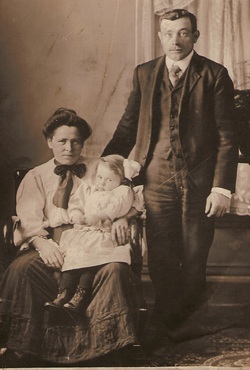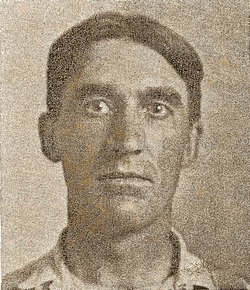Key Characters in the story about the Wolf family murders
NOTE: All ages listed are as of April 22, 1920
The Jacob Wolf Family
Jacob Wolf, 41, was born in Bergdorf, Russia, on April 18, 1879 (the marker on his grave incorrectly lists his birthdate as April 15). He came to this country in 1902 and worked in Wishek, North Dakota, before coming to Turtle Lake in 1903, where he homesteaded three miles north of town. Some years later, he moved the buildings to another site further south and two and a half miles from town. In 1905, he married Beata Bossert in Washburn, North Dakota.
Beata Wolf, 35, was born in Hoffnungstal, South Russia, on April 15, 1885. Her father was Andrew Bossert. Two of her brothers, Jacob and Rudolph, farmed near Mercer. Her older sister, Christina, was married to Emanuel Hofer and lived nearby. The Children: The Wolfs had six daughters: Bertha, 12; Maria, 9; Edna, 7; Liddia, 5; Martha, 3; and Emma, 8 months. The Hired Boy Jacob Hofer, 13, was the son of Bernhardt and Caroline Hofer. His father was a brother to Emanuel Hofer, who was married to Mrs. Wolf’s older sister, Christina. The Only Survivor
The eight-month old baby girl, Emma, was the only one to survive. She was alone from about noon Thursday until about noon Saturday when the bodies were discovered by a neighbor. She was raised by her mother’s sister, Christina Hofer, and her husband, Emanuel, until their deaths in the early 1930s. He died in 1932 and she died in 1933. Emma continued to live on their farm with three of their children. During her high school years in Turtle Lake, she stayed with Emil and Vera Haas, who were appointed her legal guardians after the death of her aunt and uncle. She worked at their general store through high school, and then attended Minot State College and obtained a teaching certificate. She married Clarence Hanson on September 29, 1940. They had three children: Priscilla, Curtis and Sheila. She died October 16, 2003, at the age of 84. Her husband, Clarence, died in February of 2009. |
The Henry Layer Family
Henry Layer, 36, was born Heinrich C. Layer on November 12, 1884 in Eigenfeld, South Russia. He came to this country in 1886 with his parents who settled near Ashley, N.D., where he lived until 1916. He was married first to Mathilda Miller in 1904, and the couple had two children, Elizabeth Katherina and Edward. They were divorced in March of 1911, and the children remained with their mother. He married Lydia Brokofsky Hinzman in Ashley on January 30, 1912. Henry was sentenced to life in the state penitentiary on Thursday, May 13, 1920, for the murders of the Wolf family and their hired boy. He and Lydia were divorced on December 21, 1922, and he died in the prison hospital on March 21, 1925. His obituary in the Bismarck Tribune said he was buried "in a local cemetery," but it is not known where he was buried (See Findagrave).
Lydia Layer, 29, was born April 4, 1891 in Bon Homme County, South Dakota. Her father was Lorenz Brokofsky. She was married first to Theodore Hinzman. The couple lived near Ashley and had one daughter, Blanche, who was born in February of 1910. The couple divorced in October of that year, and the daughter remained with her mother. She married Henry Layer in January of 1912. The couple moved from the Ashley area to their farm north of Turtle Lake in 1916. She changed her name back to Brokofsky after her husband was sent prison, and was granted a divorce on December 21, 1922. She married Jesse Benn in November of 1925. Later, they moved to Seattle, Washington, where he died in 1963 and she died in March of 1976. The Children: In addition to Lydia’s daughter, Blanche, 10, the Layers had five children together: Alvin, 6; Emil, 5; Berthold, 3; Edwin, 2; and Willard, 6 months. After their father's incarceration, all but Willard were sent to Minnesota to live with relatives, according to newspaper reports. However, a story in the Fairmont (MN) Sentinel on Oct. 14, 1922, about the death of Berthold Layer indicates that the children were in the Ward Home for orphans. Berthold died after being run over by a wagon loaded with sugar beets. The 1930 census shows that Blanche and Edwin had returned to live with their mother and youngest brother, Willard. Blanche later married Wendelin (W. E.) Welder and died in Seattle in February 1981. A Forgotten Victim: Blanche LayerThere were many victims of the Wolf family murders, but one forgotten victim was little Blanche, the 10-year-old daughter of the man convicted of the murders.
CLICK HERE for a photo and more information. |
OfficialsLynn Frazier, 45, was governor at the time of the Wolf murders. He was re-elected in November of 1920 and voted out of office in October of the next year in the first gubernatorial recall election in the country. Voted out with him were Attorney General Lemke and Agricultural Commissioner John Hagan, all members of the North Dakota Industrial Commission.
William Langer, 33, was attorney general at the time of the Wolf murders until his term expired in January of 1921 when he was replaced by William Lemke. Langer lost in his 1920 challenge to unseat the incumbent governor, Lynn Frazier, by running as the Republican Party’s candidate. Frazier and Lemke ran on the Nonpartisan League ticket. William Lemke, 41, replaced William Langer as attorney general in January of 1921, right before Judge Nuessle issued his opinion in Henry Layer’s petition for a change of plea and a trial on its merits. He was voted out of office in October of that year along with Governor Frazier and Ag Commissioner Hagan. Justice Richard Grace, 51, was the North Dakota Supreme Court justice who wrote the unanimous opinion in Henry Layer’s appeal. He served on the court from 1917 to 1922 when he resigned. He was replaced by Judge William Nuessle, who originally sentenced Layer to life in the state penitentiary and who heard his petition for a change of plea at the end of 1920. Judge William Nuessle, 41, was the district court judge who sentenced Henry Layer to life in the state penitentiary in May of 1920 and who considered his petition for a change of plea later that year. He was elected to the North Dakota Supreme Court in 1923, replacing Judge Richard Grace, who wrote the court’s opinion in the Layer appeal. Nuessle continued on the court until 1950. Sheriff Ole Stefferud, 34, was sheriff for McLean County at the time of the Wolf murders. He and his wife, Mary, and their two children lived at what was probably the sheriff’s residence near the County Courthouse. The 1920 census shows that Deputy Emil Haas, 27, lived with them. Chief Christ J. Martinson, 36, was Chief of Police in Bismarck, ND, at the time of the Wolf murders. Born in Denmark, he came to this country as a small child. He entered police work in 1904 as an attendant at the State Hospital for the Insane in Jamestown. A couple of years later he became a guard at the state penitentiary in Bismarck, where he worked for three years before becoming a patrolman in the city’s police department in 1909. Since then, he worked himself up through the ranks, and was named chief of police around 1918. He was given credit for getting the confession and solving the crime for the Wolf murders, and received the $1,000 reward the governor had offered. _______________ A UNIVERSITY OF NORTH DAKOTA CONNECTION:While an undergraduate student at the UND, Judge Nuessle was captain of the school's football team. Two of his teammates were Lynn Frazier, who was governor at the time of the Wolf murders, and William Lemke, who became attorney general a year later. |
Other Key CharactersJohn Williams, 40, was state’s attorney for McLean County at the time of the Wolf murders. He served from 1914 to 1921 when he was replaced by his clerk of court, Michael Tellefson. He stayed on to be Tellefson’s assistant state’s attorney. Both men left public office in 1923 and started a law practice together in Washburn.
Michael Tellefson, 29, was clerk of court for McLean County at the time of the Wolf murders. The next year he was elected state’s attorney for the county, replacing John Williams, who continued on as his assistant. According to the 1920 census, Tellefson was not married and lived with John Williams, his wife, son and Mrs. Williams’ parents. He left public office in 1923 when he and Williams started a law practice in Washburn. Emil Haas, 28, was deputy sheriff for McLean County at the time of the murders. He came to Turtle Lake with his family in 1904 and worked in his father's store and helped with farming operations. He served in the Army in World War I and received an honorable discharge in 1918. In the spring of 1919, Sheriff Stefferud appointed him deputy sheriff, a position he held until September 1920, five months after the Wolf murders, when he purchased his father's mercantile store. Emma Wolf, the only one to survive the murders, lived with Emil and his wife while she attended high school, and worked in their store until she graduated from high school in 1937. Henry Layer’s Lawyers Edward P. Kelly, 44, was senior partner in the Carrington, N.D., firm of Kelly & Morris that represented Henry Layer in his petition and appeal. He and James Morris had formed their firm early in 1920 not long before they were contacted by the Layer family. They dissolved their firm in 1922 when Morris was elected Foster County state’s attorney. Kelly then moved to Minneapolis where he opened a new law practice. James Morris, 27, was junior partner in the firm that represented Henry Layer. They dissolved their firm in 1922 when he was elected Foster County state’s attorney. He served as attorney general from 1928 to 1932, and was elected to the North Dakota Supreme Court where he served from 1935 to 1964. He served his first 15 years on the court with Justice Nuessle, who was the district court judge that sentenced Henry Layer and heard the petition from Layer’s lawyers, Edward Kelly and James Morris. Others Frank Sturken, 28, reporter for The Bismarck Tribune who covered the murder, investigation and appeals in the Wolf family murder. He was originally from New Jersey. He was featured as the reporter in the radio broadcast of “The Big Story” on Nov. 16, 1949, that dealt with the Wolf murders. Fred Holmboe, 40, whose real first name was Frithjof, was a studio photographer who took the photographs at the Wolf farm early in the investigation. Some of his pictures became part of the official record and some were published in The Bismarck Tribune and other papers that had requested them from the newspaper. Holmboe was a photographer for Northern Pacific Railway before opening his first photographic studio in New Salem, N.D. in 1907. In 1909, he moved to Bismarck where he opened Holmboe Photograph Studio. |